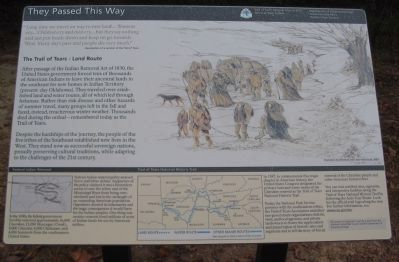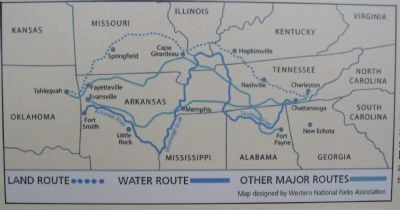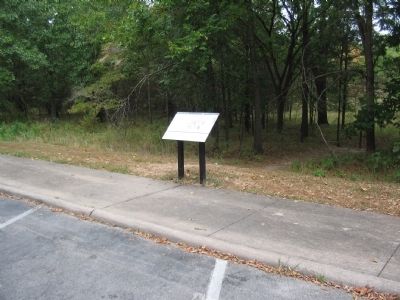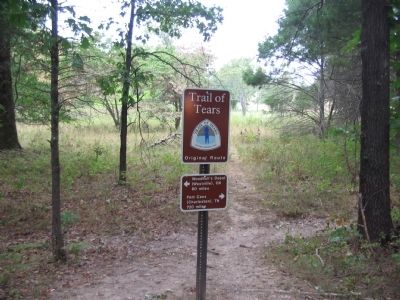Near Garfield in Benton County, Arkansas — The American South (West South Central)
They Passed This Way
Trail of Tears National Historic Trail
— National Trails System —
"Long time we travel on way to new land.... Womens cry... Children cry and men cry...but they say nothing and just put heads down and keep on go towards West. Many days pass and people die very much."
-Recollection of a survivor of the Trail of Tears
The Trail of Tears - Land Route
After passage of the Indian Removal Act of 1830, the United States government forced tens of thousands of American Indians to leave their ancestral lands in the southeast for new homes in Indian Territory (present-day Oklahoma). They traveled over established land and water routes, all of which led through Arkansas. Rather than risk disease and other hazards of summer travel, many groups left in the fall and faced, instead, treacherous winter weather. Thousands died during the ordeal - remembered today as the Trail of Tears.
Despite the hardships of the journey, the people of the five tribes of the Southeast established new lives in the West. They stand now as successful sovereign nations, proudly preserving cultural traditions, while adapting to the challenges of the 21st century.
Federal Indian Removal
In the 1830s, the federal government forcibly removed approximately 16,000 Cherokee, 21,000 Muscogee (Creek), 9,000 Choctaw, 6,000 Chickasaw, and 4,000 Seminole from the southeastern United States.
Federal Indian removal policy aroused fierce and bitter debate. Supporters of the policy claimed it was a benevolent action to save the tribes east of the Mississippi River from being overwhelmed and lost in the onslaught of an expanding American population. Opponents decried its inhumanity and the tragic consequences it would have for the Indian peoples. One thing was certain: removal freed millions of acres of Indian lands for use by American settlers.
Trail of Tears National Historic Trail
In 1987, to commemorate this tragic chapter in American history, the United States Congress designated the primary land and water routes of the Cherokee removal as the Trail of Tears National Historic Trail.
Today the National Park Service partners with the southeastern tribes; the Trail of Tears Association and other non-government organizations; federal, state, and local agencies; and private landowners to foster the appreciation and preservation of historic sites and segments and to tell the story of forced removal of the Cherokee people and other American Indian tribes.
You can visit certified sites, segments, and interpretive facilities along the Trail of Tears National Historic Trail by following the Auto Tour Route. Look for the official trail logo along the way. For further information, see: www.nps.gov/trte.
Erected by Department of Arkansas Heritage, Arkansas State Parks, and National Park Service.
Topics and series. This historical marker is listed in this topic list: Native Americans. In addition, it is included in the Trail of Tears series list. A significant historical year for this entry is 1830.
Location. 36° 26.555′ N, 94° 1.766′ W. Marker is near Garfield, Arkansas, in Benton County. Marker is on Military Park Road (County Road 65). Located at stop one, Trail of Tears, on the driving tour of Pea Ridge National Military Park. Touch for map. Marker is in this post office area: Garfield AR 72732, United States of America. Touch for directions.
Other nearby markers. At least 8 other markers are within walking distance of this marker. The Enemy Is Behind Us! (approx. 0.2 miles away); U.S. Army Headquarters 1862 (approx. 0.2 miles away); City of Soldiers (approx. 0.2 miles away); Getting Ready To Fight (approx. 0.2 miles away); That Beautiful Charge (approx. 0.4 miles away); "Dat De Shpot, Sergent!" (approx. 0.4 miles away); A Perfect Storm of Shot and Shell (approx. 0.6 miles away); Confederate Sunset (approx. 0.6 miles away). Touch for a list and map of all markers in Garfield.
Also see . . . Trail of Tears National Historic Trail. National Park Service website entry (Submitted on September 7, 2010, by Craig Swain of Leesburg, Virginia.)
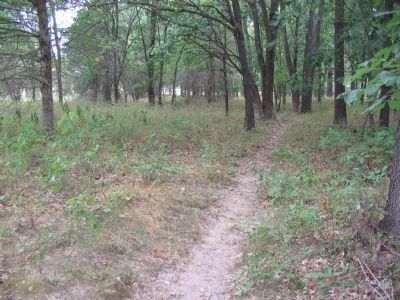
Photographed By Craig Swain, August 30, 2010
5. Trail Path
The park trail is the remnant of the old Telegraph Road which was used by the Indians on the Trail of Tears. The same road was used for the Butterfield Overland Stage from 1857 to 1861. And the road was used by both armies during the Civil War.
Credits. This page was last revised on September 28, 2021. It was originally submitted on September 7, 2010, by Craig Swain of Leesburg, Virginia. This page has been viewed 1,665 times since then and 21 times this year. Photos: 1, 2, 3, 4, 5. submitted on September 7, 2010, by Craig Swain of Leesburg, Virginia.
